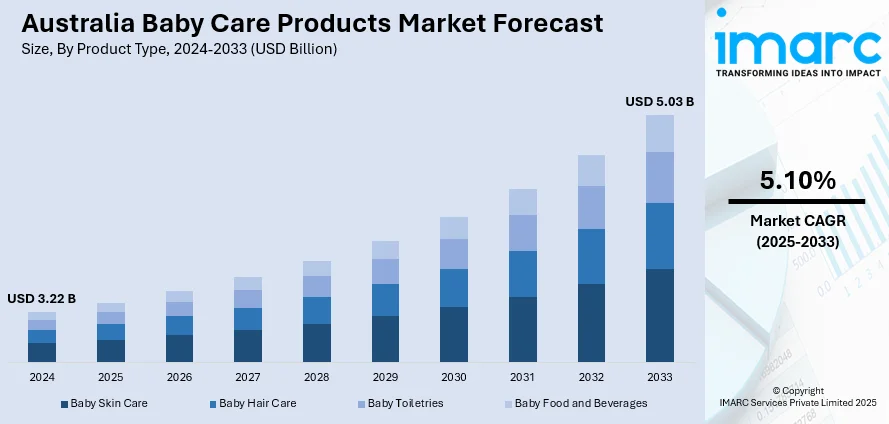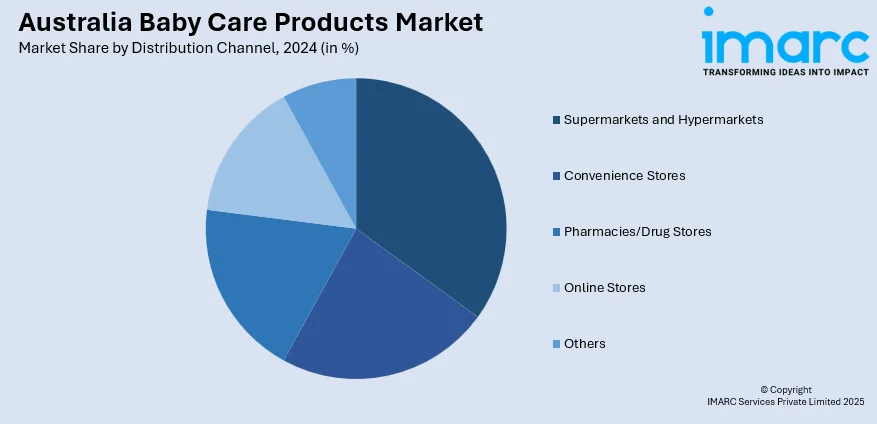
Australia Baby Care Products Market Size, Share, Trends and Forecast by Product Type, Category, Distribution Channel, and Region, 2025-2033
Australia Baby Care Products Market Overview:
The Australia baby care products market size reached USD 3.22 Billion in 2024. Looking forward, IMARC Group expects the market to reach USD 5.03 Billion by 2033, exhibiting a growth rate (CAGR) of 5.10% during 2025-2033. The market is experiencing significant growth due to rising demand for organic, premium, and plant-based solutions. Moreover, growth is driven by health-conscious parents, digital retail channels, and innovation in baby food, toiletries, and skincare across diverse income segments.
|
Report Attribute
|
Key Statistics
|
|---|---|
|
Base Year
|
2024
|
|
Forecast Years
|
2025-2033
|
|
Historical Years
|
2019-2024
|
| Market Size in 2024 | USD 3.22 Billion |
| Market Forecast in 2033 | USD 5.03 Billion |
| Market Growth Rate 2025-2033 | 5.10% |
Australia Baby Care Products Market Trends:
Rising Demand for Organic and Natural Products
Australian parents are placing greater emphasis on ingredient safety leading to a shift toward organic and naturally derived baby care products. This preference is driving Australia baby care products market growth especially in the skin care, hair care, and toiletries segments. Shoppers are actively avoiding products with parabens, sulfates, synthetic fragrances, and other harsh chemicals opting instead for items made with aloe vera, coconut oil, shea butter, and botanical extracts. Brands that emphasize non-toxic, cruelty-free, and eco-certified labels are gaining strong traction particularly among millennial and first-time parents. Retailers are also expanding shelf space for organic ranges while online platforms promote natural baby care through targeted advertising and parent-focused reviews. As this clean-label movement strengthens it is expected to significantly influence purchasing behavior and contribute to the expanding Australia baby care products market share.

To get more information on this market, Request Sample
Expansion of Baby Food and Beverages
The baby food and beverages segment in Australia is evolving rapidly, with increasing demand for organic, plant-based, and allergen-free options. Parents are becoming more conscious of nutritional transparency and ingredient sourcing, seeking products that are free from artificial additives, preservatives, and common allergens such as dairy, soy, and gluten. This shift is fostering innovation in infant formulas, toddler drinks, and snack items made from coconut, oat, almond, quinoa, and other plant-based sources. The rise in vegan and flexitarian households is also contributing to this trend, with brands offering Clean Label-certified and minimally processed alternatives. Convenient formats like pouches and ready-to-feed drinks are gaining traction for on-the-go consumption. For instance, in April 2024, Else Nutrition launched its first plant-based infant formula and toddler drink in Australia, offering dairy and soy-free alternatives for infants and toddlers. The products are Clean Label certified, made primarily from almonds and buckwheat, and comply with regulatory standards. With parents prioritizing health, digestion, and developmental support, the segment is set to create a positive Australia baby care products market outlook.
Growth in Premium Baby Care Segment
Australian parents are increasingly prioritizing quality, safety, and trusted ingredients when it comes to baby care, fueling strong growth in the premium segment. Products that emphasize dermatological testing, organic certification, and hypoallergenic formulations are especially sought after. From skin care to baby toiletries and nutrition, premium offerings often include plant-based ingredients, sustainable packaging, and enhanced functionality attributes that resonate with modern, health-conscious families. This shift is also being driven by rising disposable incomes, delayed parenthood, and greater awareness around infant wellness. Brands that position themselves as clean, ethical, and transparent are gaining an edge in both retail and online channels. Many parents now view premium baby products as an investment in their child’s health and development rather than a luxury. As a result, the premium category is carving out a growing share within the overall baby care landscape in Australia.
Australia Baby Care Products Market Segmentation:
IMARC Group provides an analysis of the key trends in each segment of the market, along with forecasts at the regional level for 2025-2033. Our report has categorized the market based on product type, category, and distribution channel.
Product Type Insights:
- Baby Skin Care
- Baby Hair Care
- Baby Toiletries
- Baby Bath Products and Fragrances
- Baby Diapers and Wipes
- Baby Food and Beverages
The report has provided a detailed breakup and analysis of the market based on the product type. This includes baby skin care, baby hair care, baby toiletries (baby bath products and fragrances and baby diapers and wipes), and baby food and beverages.
Category Insights:
- Premium
- Mass
A detailed breakup and analysis of the market based on the category have also been provided in the report. This includes premium and mass.
Distribution Channel Insights:

- Supermarkets and Hypermarkets
- Convenience Stores
- Pharmacies/Drug Stores
- Online Stores
- Others
A detailed breakup and analysis of the market based on the distribution channel have also been provided in the report. This includes supermarkets and hypermarkets, convenience stores, pharmacies/drug stores, online stores, and others.
Regional Insights:
- Australia Capital Territory & New South Wales
- Victoria & Tasmania
- Queensland
- Northern Territory & Southern Australia
- Western Australia
The report has also provided a comprehensive analysis of all the major regional markets, which include Australia Capital Territory & New South Wales, Victoria & Tasmania, Queensland, Northern Territory & Southern Australia, and Western Australia.
Competitive Landscape:
The market research report has also provided a comprehensive analysis of the competitive landscape. Competitive analysis such as market structure, key player positioning, top winning strategies, competitive dashboard, and company evaluation quadrant has been covered in the report. Also, detailed profiles of all major companies have been provided.
Australia Baby Care Products Market News:
- In October 2024, Australian company Coco2 launched the world’s first coconut-based infant formula, developed over ten years with the University of Queensland. The formula closely mimics breast milk, containing essential nutrients and lauric acid. Available in three varieties, Coco2 aims to provide allergen-free options for infants with dietary restrictions.\
- In September 2023, HUGGIES Australia launched innovative Newborn and Infant nappies featuring a zinc-enriched layer designed to protect babies' delicate skin from irritation. Research shows skin issues are a top concern for parents, and this first-of-its-kind product aims to provide peace of mind while ensuring comfort and absorbency.
Australia Baby Care Products Market Report Coverage:
| Report Features | Details |
|---|---|
| Base Year of the Analysis | 2024 |
| Historical Period | 2019-2024 |
| Forecast Period | 2025-2033 |
| Units | Billion USD |
| Scope of the Report |
Exploration of Historical Trends and Market Outlook, Industry Catalysts and Challenges, Segment-Wise Historical and Future Market Assessment:
|
| Product Types Covered |
|
| Categories Covered | Premium, Mass |
| Distribution Channels Covered | Supermarkets and Hypermarkets, Convenience Stores, Pharmacies/Drug Stores, Online Stores, Others |
| Regions Covered | Australia Capital Territory & New South Wales, Victoria & Tasmania, Queensland, Northern Territory & Southern Australia, Western Australia |
| Customization Scope | 10% Free Customization |
| Post-Sale Analyst Support | 10-12 Weeks |
| Delivery Format | PDF and Excel through Email (We can also provide the editable version of the report in PPT/Word format on special request) |
Key Benefits for Stakeholders:
- IMARC’s industry report offers a comprehensive quantitative analysis of various market segments, historical and current market trends, market forecasts, and dynamics of the Australia baby care products market from 2019-2033.
- The research report provides the latest information on the market drivers, challenges, and opportunities in the Australia baby care products market.
- Porter's five forces analysis assist stakeholders in assessing the impact of new entrants, competitive rivalry, supplier power, buyer power, and the threat of substitution. It helps stakeholders to analyze the level of competition within the Australia baby care products industry and its attractiveness.
- Competitive landscape allows stakeholders to understand their competitive environment and provides an insight into the current positions of key players in the market.
Key Questions Answered in This Report
The baby care products market in Australia was valued at USD 3.22 Billion in 2024.
The Australia baby care products market is projected to exhibit a CAGR of 5.10% during 2025-2033, reaching a value of USD 5.03 Billion by 2033.
The market growth is fuelled by growing awareness of baby hygiene and infant health, rising disposable incomes, and lifestyle changes among parents. The demand for organic and natural baby care products, convenience products, and electronic platforms that enable product availability also plays a strong supporting role. Furthermore, improvements in packaging and safety features also spur adoption in the market.
Need more help?
- Speak to our experienced analysts for insights on the current market scenarios.
- Include additional segments and countries to customize the report as per your requirement.
- Gain an unparalleled competitive advantage in your domain by understanding how to utilize the report and positively impacting your operations and revenue.
- For further assistance, please connect with our analysts.
 Request Customization
Request Customization
 Speak to an Analyst
Speak to an Analyst
 Request Brochure
Request Brochure
 Inquire Before Buying
Inquire Before Buying




.webp)




.webp)












